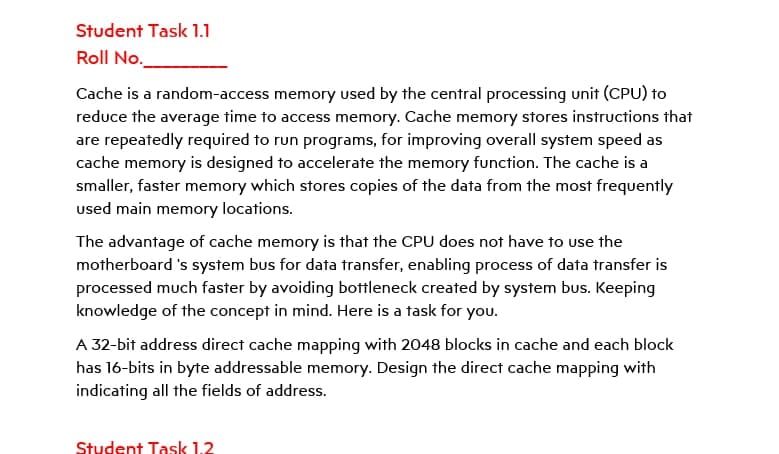A 32-bit address direct cache mapping with 2048 blocks in cache and each block has 16-bits in byte addressable memory. Design the direct cache mapping with indicating all the fields of address.
A 32-bit address direct cache mapping with 2048 blocks in cache and each block has 16-bits in byte addressable memory. Design the direct cache mapping with indicating all the fields of address.
Computer Networking: A Top-Down Approach (7th Edition)
7th Edition
ISBN:9780133594140
Author:James Kurose, Keith Ross
Publisher:James Kurose, Keith Ross
Chapter1: Computer Networks And The Internet
Section: Chapter Questions
Problem R1RQ: What is the difference between a host and an end system? List several different types of end...
Related questions
Question
100%
Do not explain . I want only the diagram (neat and clean ) . Please solve it in few minutes .

Transcribed Image Text:Student Task 1.1
Roll No.
Cache is a random-access memory used by the central processing unit (CPU) to
reduce the average time to access memory. Cache memory stores instructions that
are repeatedly required to run programs, for improving overall system speed as
cache memory is designed to accelerate the memory function. The cache is a
smaller, faster memory which stores copies of the data from the most frequently
used main memory locations.
The advantage of cache memory is that the CPU does not have to use the
motherboard 's system bus for data transfer, enabling process of data transfer is
processed much faster by avoiding bottleneck created by system bus. Keeping
knowledge of the concept in mind. Here is a task for you.
A 32-bit address direct cache mapping with 2048 blocks in cache and each block
has 16-bits in byte addressable memory. Design the direct cache mapping with
indicating all the fields of address.
Student Task 1.2
Expert Solution
This question has been solved!
Explore an expertly crafted, step-by-step solution for a thorough understanding of key concepts.
This is a popular solution!
Trending now
This is a popular solution!
Step by step
Solved in 2 steps with 1 images

Recommended textbooks for you

Computer Networking: A Top-Down Approach (7th Edi…
Computer Engineering
ISBN:
9780133594140
Author:
James Kurose, Keith Ross
Publisher:
PEARSON

Computer Organization and Design MIPS Edition, Fi…
Computer Engineering
ISBN:
9780124077263
Author:
David A. Patterson, John L. Hennessy
Publisher:
Elsevier Science

Network+ Guide to Networks (MindTap Course List)
Computer Engineering
ISBN:
9781337569330
Author:
Jill West, Tamara Dean, Jean Andrews
Publisher:
Cengage Learning

Computer Networking: A Top-Down Approach (7th Edi…
Computer Engineering
ISBN:
9780133594140
Author:
James Kurose, Keith Ross
Publisher:
PEARSON

Computer Organization and Design MIPS Edition, Fi…
Computer Engineering
ISBN:
9780124077263
Author:
David A. Patterson, John L. Hennessy
Publisher:
Elsevier Science

Network+ Guide to Networks (MindTap Course List)
Computer Engineering
ISBN:
9781337569330
Author:
Jill West, Tamara Dean, Jean Andrews
Publisher:
Cengage Learning

Concepts of Database Management
Computer Engineering
ISBN:
9781337093422
Author:
Joy L. Starks, Philip J. Pratt, Mary Z. Last
Publisher:
Cengage Learning

Prelude to Programming
Computer Engineering
ISBN:
9780133750423
Author:
VENIT, Stewart
Publisher:
Pearson Education

Sc Business Data Communications and Networking, T…
Computer Engineering
ISBN:
9781119368830
Author:
FITZGERALD
Publisher:
WILEY